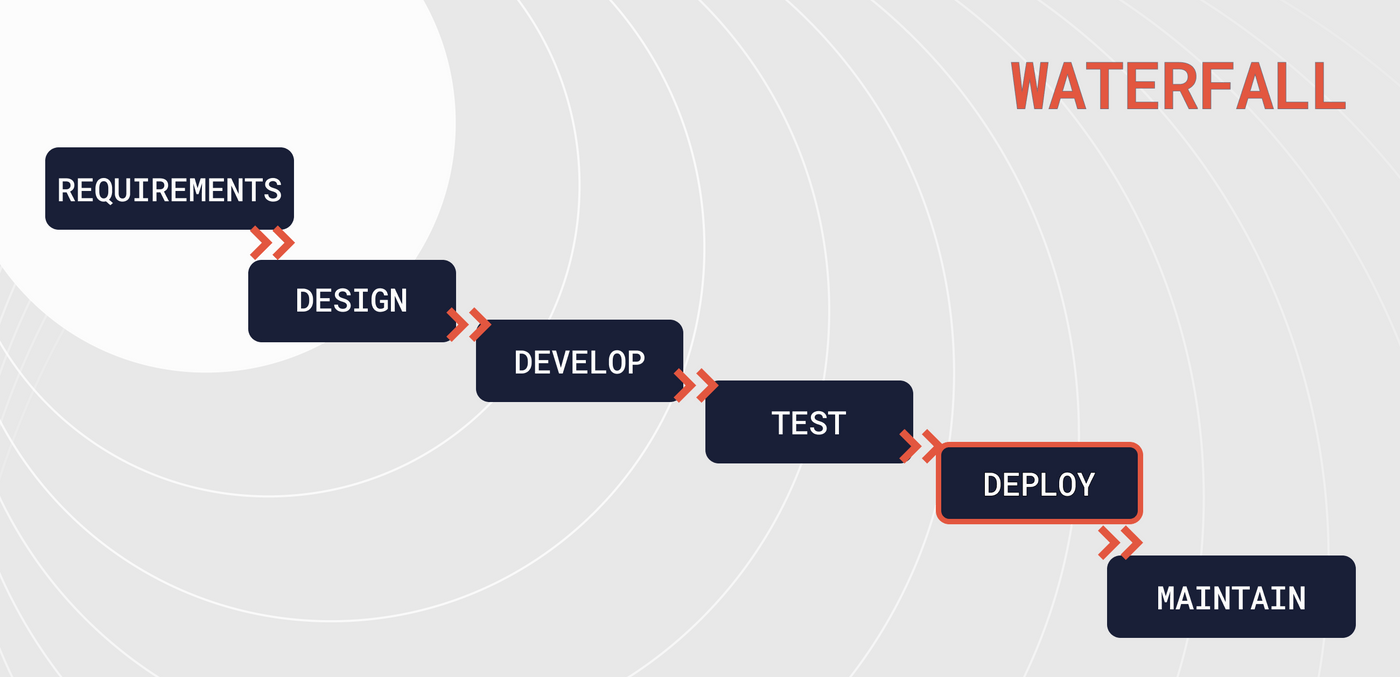Each methodology has its unique strengths and is designed to align with specific goals and challenges. Finding that sweet spot between structure and adaptability is key for organisations striving to create a striving to achieve their project goals or project vision. Let’s dive into the world of project methodologies and discover how to choose the best one for your next endeavour.
Waterfall: Best suited to long term projects
Imagine a well-oiled machine humming along predictably—that's the waterfall method for you. One of the most established project methodologies, waterfall shines brightly in environments with fixed budgets, timelines, and transparent requirements. With its linear approach, each stage of the project unfolds sequentially, meaning you must complete one phase before jumping into the next. This model is perfect for projects that crave upfront clarity, like compliance-focused initiatives or those tangled in strict regulatory standards. It also works for when stakeholders need time and space to review one deliverable before being able to moving onto the next.
We find Waterfall to be especially useful for updating or uplifting legacy technology. An example of this methodology in action is the Modernisation of the ‘Day of Operation’ System for the Melbourne Tram Network project.
Pros: Predictability, budget control, strict governance and documentation and clear milestones keep your project on track.
Cons: Limited flexibility and a struggle to adapt to unexpected changes can challenge your progress.
Best fit: Waterfall is preferred when you have fixed budgets, timelines and defined scope.

Agile: Best suited to incremental projects
Agile methodology has transformed project management with its dynamic, iterative approach. It's all about adaptability, quick decision-making, and fostering collaboration. Agile shines in projects where the scope isn't set in stone, making it a favourite in software development and human-centred design. Expect frequent consultation with the product owner and iterative adjustments to ensure the final product aligns with user needs and market trends.
We used the Agile methodology in our recent work with WorkSafe to create the foundations of a design system proof of concept, as it allowed for full flexibility and human-centred design.
Pros: Flexibility, adaptability to changes, and continuous user feedback can elevate your project’s quality.
Cons: This approach demands a significant time investment and active collaboration from all stakeholders. It doesn't lend itself to fixed budgets and timelines, and has limited documentation.
Best fit: Agile is your go-to for projects driven by experimentation and real-time feedback with a strong product owner.

Hybrid: For adaptable structure
What if you could have the best of both worlds? Enter hybrid models, where structure meets adaptability. Often dubbed “wagile,” these approaches blend the predictability of waterfall with the flexibility of agile. Designed for teams that crave collaborative, user-centred design while navigating realistic constraints, hybrid models allow for structured phases that can still iterate within their confines.
A large portion of our projects take a hybrid approach, with the structure and forward momentum from Waterfall and smaller incremental sprints of Agile. Our work with equivant is an excellent example of this.
Pros: A balanced approach that offers structure while supporting evolving client needs.
Cons: Requires careful planning to dodge confusion and misalignment along the way.
Best Fit: Hybrid models excel in projects that demand both predictability and flexibility, like digital design tasks with ever-changing requirements and fixed budgets.
Choosing your path: Key considerations
Selecting the right project methodology isn’t just a checklist; it’s a strategic decision that should align with your project’s unique goals, client requirements, and available resources. As you embark on this decision-making journey, here are some vital questions to ponder:
How fixed are your project scope, budget and timeline?
Consider your constraints. If rigidity is the name of the game, waterfall or hybrid approaches might be your best options. However, if flexibility of scope is a key factor, agile could be your ideal match.
What level of collaboration is feasible with stakeholders?
Agile needs on ongoing client input and collaboration. If this isn’t possible, waterfall or hybrid models may prove more effective as it has more formal checks and sign off points. This is especially useful if only some stakeholders can be involved in every meeting.
Is innovation a priority for your project?
Agile’s room for exploration and iteration makes it perfect for projects swayed by user insights or market trends.
What impact will your project have?
If your goal is to create meaningful impact, hybrid and agile methodologies allow you to adapt the project based on real-world needs.
In the grand tapestry of project management, understanding your project’s goals, constraints and needs is essential for selecting the best methodology. Whether you lean towards waterfall, embrace agility, or try a hybrid approach, each methodology has unique strengths to help you drive efficiency and achieve your project objectives. Choose wisely, and watch your project thrive!
Need more support?
We run facilitated workshops that can jump start or revitalise your project.